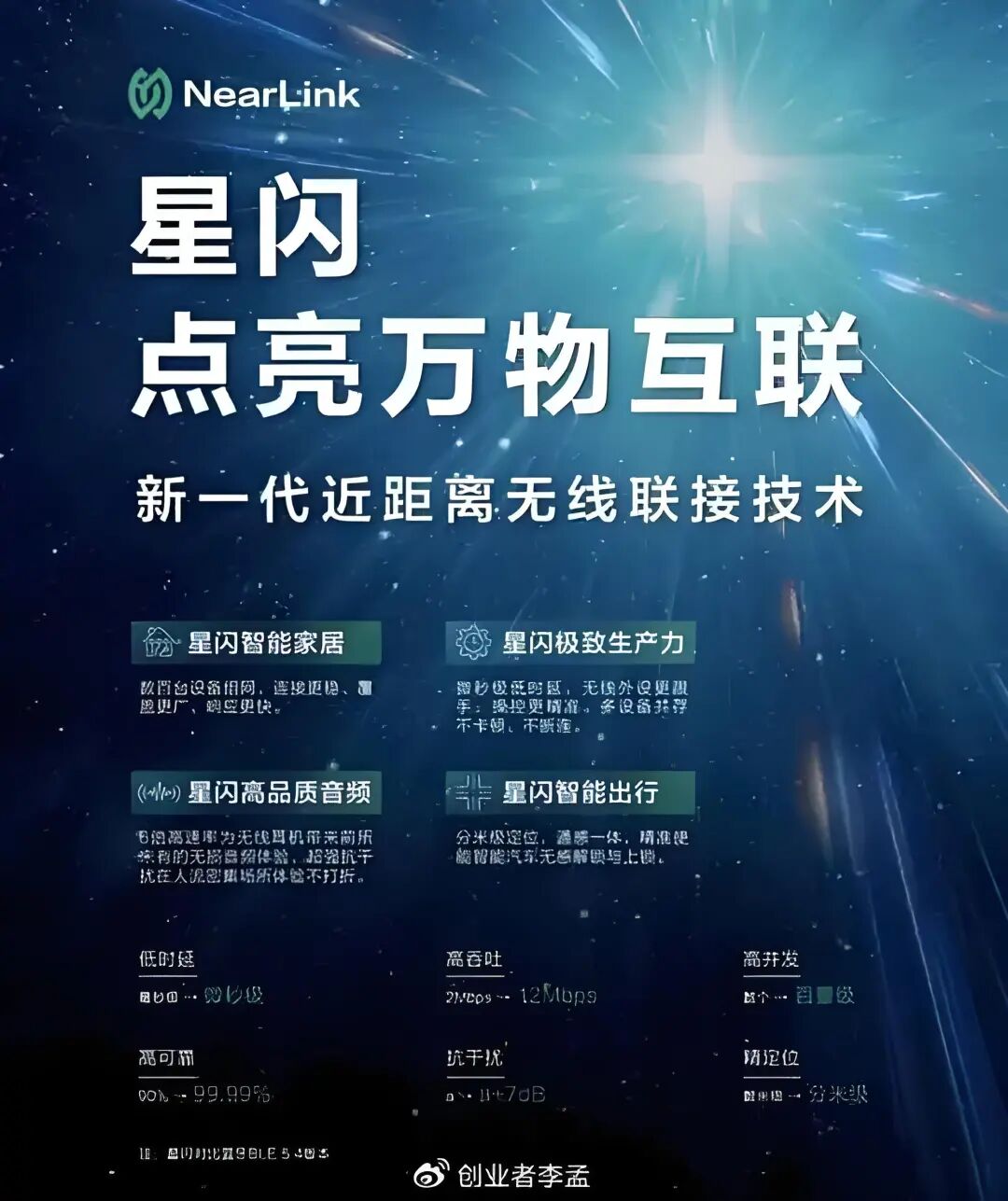
1. Technical Definition and Positioning
SparkLink is a new generation of short-range wireless communication technology led by China, promoted by the International SparkLink Alliance. It aims to address the bottlenecks of traditional Bluetooth and Wi-Fi in areas such as latency, power consumption, and connection scale. Its core positioning is to become the “connectivity foundation” of the Internet of Everything era, adapting to diverse scenario needs such as smart homes, industrial interconnectivity, and the Internet of Vehicles through the integration of low power consumption and high-speed dual modes (SLB and SLE).
2. Technical Advantages and Breakthroughs
Comprehensive Performance Parameters Leading the Industry
Low Latency: The minimum one-way latency in the air interface is 20 microseconds (SLB mode), only 1/30 of Bluetooth and 1/10 of Wi-Fi.
High Concurrency: Supports simultaneous connections of 4096 devices, far exceeding Bluetooth (about 8 devices) and Wi-Fi (about 200 devices).
Strong Anti-Interference: Adaptive frequency hopping technology enhances anti-interference capability, with a packet loss rate of less than 0.001%.
Energy Efficient: At the same rate, power consumption is 60% lower than Bluetooth, with a transmission rate of up to 1.2Gbps (SLB mode).
Innovative Dual-Mode Architecture
SLB Mode: Comparable to Wi-Fi, used for high-speed scenarios (such as HD video transmission and industrial control), with a coverage range of up to 200 meters.
SLE Mode: Comparable to Bluetooth, focusing on low-power scenarios (such as wearable devices and smart homes), supporting centimeter-level high-precision positioning.
3. Application Scenarios and Case Studies
Consumer Electronics
Smart Home: The COLMO refrigerator uses SparkLink radar sensing for automatic human wake-up, and the Casarte TV remote control supports high-precision directional interaction.
Peripheral Devices: The Ugreen G908 mouse achieves 0.25ms ultra-low latency, comparable to wired devices.
Industry and Automotive
Smart Manufacturing: The SparkLink industrial wireless solution launched by Sirunhua addresses complex production line wiring and limited equipment mobility.
Internet of Vehicles: The Eagle Drive Technology’s vehicle-mounted 360° surround view system utilizes SparkLink’s low-latency characteristics to eliminate visual blind spots.
Emerging Fields
Energy and Medical: Runhe Software applies SparkLink in power distribution and coal mining scenarios, enhancing safety and efficiency.
Education and Research: Harbin Institute of Technology (Shenzhen) explores wireless architecture innovation of SparkLink in industrial automation.
4. Ecological Development and Commercialization Process
Alliance and Ecological Construction
There are over 1100 members in the SparkLink Alliance, covering fields such as chips, terminals, and automotive electronics.
The SparkLink standard 2.0 will be released in 2025, adding high-precision positioning and perception capabilities to promote global layout.
Policy and Industry Collaboration
The Shenzhen government leads the hosting of industry summits to promote SparkLink technology as a national strategic innovation direction.
Huawei’s HarmonyOS deeply integrates SparkLink, establishing it as the highest-level connectivity standard (S+ standard).
5. Challenges and Future Prospects
Commercialization Challenges
Ecological Barriers: Need to break through the existing monopolies of Bluetooth/Wi-Fi, with current module costs being 30% higher than Bluetooth.
Technical Iteration: The SparkLink 3.0 standard is expected to be launched in 2025, introducing millimeter-wave frequency bands and achieving rates exceeding 10Gbps.
Market Potential
Short-term Goal: The shipment volume of vehicle-mounted modules is expected to reach 108 million pieces by 2025, with the application scale of industrial robots exceeding 70 billion yuan.
Long-term Vision: By 2030, the goal is to become a globally leading short-range communication standard dominated by China, with a smart home penetration rate exceeding 30%.
SparkLink technology, through its “dual-mode architecture + 5G integration” design, achieves breakthroughs in low latency, high reliability, and multi-concurrency, reshaping the connectivity standards in fields such as smart vehicles and industrial manufacturing. Its ecological expansion and policy support provide strong momentum for technology implementation, but continuous optimization in cost control and ecological compatibility is necessary. In the future, SparkLink is expected to become a key infrastructure in the era of the Internet of Everything.